#saadian
Text


Morocco - Ben Yousef Madrasa (2) by hey tiffany!
#courtyard#madrasa#madrassa#tiles#saadian architecture#moorish architecture#moroccan architecture#morocco#marrakesh#marrakech
4 notes
·
View notes
Text

Height check (but it’s said like the “vibe check” before you get slapped to the afterlife)
This is the main cast of House Pheopiya
Kalcius Malheart II / Áine Voland / Moksha Nissim / Adenike Saadian / Eske Posilon
#planet oelios#my art#eskes oc stuff#pngtuber#Kalcius Malheart II#Aine Voland#Moksha Nissim#Adenike Saadian
5 notes
·
View notes
Text
Explore Marrakech's Vibrant History and Culture - Top 5 Tourist Attractions Await
youtube
Explore Marrakech's Vibrant History and Culture - Top 5 Tourist Attractions Await
Marrakech, a vibrant city in Morocco, is a must-visit destination for travelers seeking to immerse themselves in the rich history and culture of North Africa. With its vibrant markets, stunning architecture, and breathtaking landscapes, Marrakech is a true gem of the region.
One of the city's most iconic attractions is the Jardin Majorelle, a stunning botanical garden created by French artist Jacques Majorelle in the early 20th century. With its vibrant blue walls, exotic plants, and tranquil pools, the garden is a serene oasis in the heart of the bustling city.
Another must-see attraction is the Bahia Palace, a magnificent 19th-century palace that showcases the city's rich architectural heritage. With its intricate tilework, carved woodwork, and stunning gardens, the palace is a true masterpiece of Moroccan design.
For those interested in the city's religious heritage, the Koutoubia Mosque is the largest mosque in the city and boasts a stunning minaret that is visible from miles away. The mosque is an architectural wonder and an important part of the city's history.
One of the most unique attractions in Marrakech is the Saadian Tombs, a stunning complex of tombs and mausoleums that date back to the 16th century. With its intricate tilework and ornate carvings, the site is a testament to the city's rich cultural heritage.
Last but not least, the Museum of Moroccan Arts is a must-visit destination for art lovers and history buffs. Housed in a stunning 19th-century palace, the museum features an impressive collection of traditional Moroccan crafts and artifacts, including textiles, ceramics, jewelry, and metalwork.
In summary, Marrakech is a city that offers a wealth of attractions and experiences for travelers of all interests. From the tranquil beauty of the Jardin Majorelle to the stunning architecture of the Bahia Palace and the Saadian Tombs, there is no shortage of things to see and do in this vibrant and culturally rich city.
#Youtube#marrakech#morocco#marrakesh#best places to visit#top 10#top 5 places to visit#Menara Gardens#jamaaelfna#bahia palace#saadian Tombs#Majorelle Garden#travel guide#morocco travel guide#Marrakech travel vlogs#Marrakech travel guide#Marrakech travel#travel Video#travel videos#travel#top 10 best places#top places to visit
2 notes
·
View notes
Text



Marrakech, 2022
Saadian tombs
2 notes
·
View notes
Text


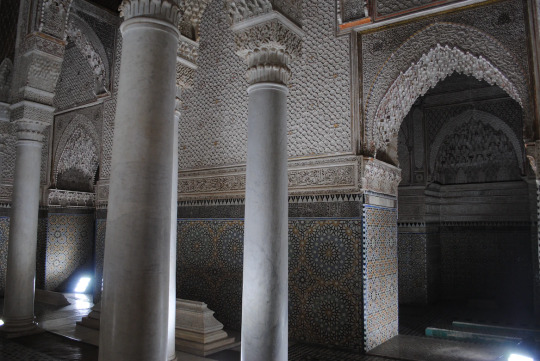
Saadian Tombs, Marrakech, Morocco
JR Harris
0 notes
Text
And thus, to wrap things up, the context of Tondibi, which fell upon the Songhai like the wolf upon the fold:
And as a result of the legacy of the Wattasids and the influence of the Ottomans, Safavids, and Mughals the Saadi dynasty that replaced them built an extremely efficient gunpowder army of its own. This army was able to ultimately evict European colonialism and to keep it out as long as it existed. The same influences that led it to do the one also led it to raid the Songhai for gold and wealth, and that process, as well as the raw power of the gunpowder empire age colliding into them with an inexorable power, set in motion all else that followed.
Ultimately the core of the battle that began the long and gruesome litany of horrors called the slave trade was the transformation of Moroccan Muslim states from light cavalry with swords and lances to gunpowder forces with cannons and muskets. Not from mindless aggression, from seeking to succeed where the Wattasids failed, doing so, and needing to recoup the expenses of the brave new modern army they built to do it.
#lightdancer comments on history#black history month#moroccan history#battle of tondibi#saadian dynasty#al-mansur of morocco#african history
0 notes
Note
Not to sound dumb or anything, but is Maghreb only Morocco or also other countries? And what’s with the Tunisia/Algeria thing bc I’ve seen a lot of beef but idk if it’s not really a thing irl🧍🏽♀️
That's not a dumb question at all! Maghreb refers to sunset, when the sun sets obviously in the west: since north africa is the most western part of the arab world, when Arabs came they called that part of North Africa Al-Maghrib (Morocco, Mauritania, Algeria, Tunisia and Libya) which is what is called internationally. Morocco itself was known with different names throughout its history based on the various dynasties that took power: The Kingdom of Fes at some point (which is why Morocco is called Fas in turkish) and then the Kingdom of Marrakech (> which is why it's called Morocco in english, Marocco in italian, Marruecos in spanish, Maroc in french etc...they are all derived names from Marrakech). Then the first dynasty who claimed to be descendants of the Prophet, the Saadians, called it Al-Mamlaka Al-Maghribiya which literally means "western Kingdom" since Morocco is the further western country in the Arab world. And that's why it's called Al-Maghrib or simply Maghrib (or typed Maghreb) in arabic! Hope it makes sense. So yeah the name in arabic refers to the country, but also the rest of the world call the whole area Maghreb.
And for the beef...Moroccans and Algerians have the worst beef ever cause of borders and closeness and some political tensions so yeah it's very much real. It's more chill between Morocco and Tunisia but still...we do take the piss of each other a lot and sometimes sadly we don't get along especially in the diaspora 😭
8 notes
·
View notes
Text

El Badi Palace. 👑 This popular Marrakech spot opened in 1593
El Badi Palace or Badi' Palace is a ruined palace located in Marrakesh, Morocco. It was commissioned by the sultan Ahmad al-Mansur of the Saadian dynasty
The palace, decorated with materials imported from numerous countries ranging from Italy to Mali, was used for receptions and designed to showcase the Sultan's wealth and powe. It was one part of a larger Saadian palace complex occupying the Kasbah district of Marrakesh.
The palace was neglected after al-Mansur's death in 1603 and eventually fell into ruin with the decline of the Saadian dynasty.
Photo credit :
instagram
2 notes
·
View notes
Text
10 Must-See Destinations in Morocco That Will Leave You Spellbound
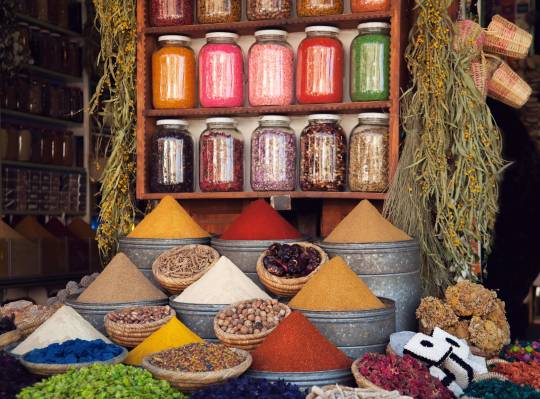
culture
Morocco is a North African country that is rich in history, culture, and natural beauty. From the bustling city of Marrakech to the peaceful town of Chefchaouen, Morocco has a lot to offer to travelers who are seeking unique experiences.
Marrakech
Marrakech is a vibrant city that is known for its bustling markets, traditional architecture, and historic landmarks. One of the must-see landmarks in Marrakech is the Jemaa el-Fnaa square, which is home to snake charmers, street performers, and delicious street food. Other must-see landmarks include the Koutoubia Mosque, Bahia Palace, and the Saadian Tombs.
Casablanca
Casablanca is the economic capital of Morocco and home to the largest mosque in Africa, the Hassan II Mosque. The mosque is a stunning structure that showcases intricate Moroccan architecture and offers a breathtaking ocean view. Other notable landmarks in Casablanca include the Rick's Cafe and the Royal Palace of Casablanca.
Fes
Fes is a city that is steeped in history and culture. The city is home to the oldest university in the world, the University of Al Quaraouiyine, which dates back to the 9th century. Fes is also famous for its traditional tanneries, which have been producing leather goods for centuries. Other must-see landmarks include the Bou Inania Madrasa, the Dar Batha Museum, and the Royal Palace of Fes.
Chefchaouen
Chefchaouen is a small town that is located in the Rif Mountains. The town is known for its blue-painted buildings and peaceful atmosphere. Chefchaouen is a great place to relax and enjoy the scenic views of the surrounding mountains. Other notable landmarks include the Kasbah Museum and the Ras Elma River.
Essaouira
Essaouira is a coastal city that is known for its relaxed atmosphere and beautiful beaches. The city is also famous for its historic fortifications and traditional fishing port. Other must-see landmarks include the Skala de la Ville, the Essaouira Citadel, and the Sidi Mohammed Ben Abdallah Museum.
Rabat
Rabat is the capital city of Morocco and home to the Mausoleum of Mohammed V, which is a stunning example of Moroccan architecture. The city is also home to the Hassan Tower, which is an incomplete mosque that dates back to the 12th century. Other notable landmarks include the Royal Palace of Rabat and the Chellah Necropolis.
Atlas Mountains
The Atlas Mountains are a stunning range that spans across Morocco, Algeria, and Tunisia. The mountains are home to traditional Berber villages and breathtaking landscapes. A trek through the Atlas Mountains is a must-do activity for any adventurous traveler.
Sahara Desert
The Sahara Desert is the largest hot desert in the world and covers most of North Africa. The desert is a magical place with towering sand dunes and clear night skies. A camel trek through the desert is an experience that you will never forget.
Ouarzazate
Ouarzazate is a city that is located in the middle of the desert and is known as the gateway to the Sahara. The city is home to the Kasbah of Taourirt, which is a stunning example of Moroccan architecture. Ouarzazate is also a popular filming location for Hollywood movies and TV shows.
Agadir
Agadir is a coastal city that is known for its beautiful beaches and relaxed atmosphere. The city is a popular tourist destination and offers a range of activities, including surfing, golfing, and hiking in the nearby hills.
In conclusion, Morocco is a country that is full of unique experiences for travelers. From the vibrant city of Marrakech to the peaceful town of Chefchaouen, and from the stunning Atlas Mountains to the magical Sahara Desert, there is something for everyone in Morocco. The country is rich in history, culture, and natural beauty, and a visit to any of these ten must-see destinations is sure to leave you spellbound. Whether you are seeking adventure, relaxation, or simply a chance to explore a new culture, Morocco is a destination that should be on your travel bucket list.
#Morocco tours#traveling#Morocco travel#Moroccan culture#Sahara desert#Atlas Mountains#Marrakech#Casablanca#Fes#Rabat#Chefchaouen#Essaouira#adventure tourism#camel trekking#traditional markets#Moroccan food#Berber villages#Islamic architecture#beach resorts#North Africa#Maghreb region.#wanderlust#travel photography
6 notes
·
View notes
Text


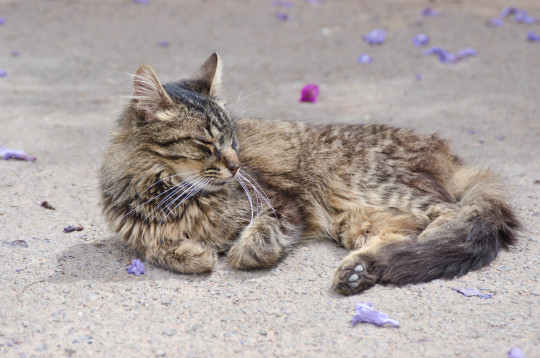
Morocco (2) (3) by hey tiffany!
Via Flickr:
(1) (2) Saadian Tombs
2 notes
·
View notes
Link
ooOOOoOoOO You want to read about Kalcius Malheart II and Adenike Saadian so bad. They are GAY and IN LOVE. they are CHILDHOOD BEST FRIENDS.
(Also mind the tags on this one, i mean half of it does take place mid war)
#Planet Oelios#Adenike Saadian#Kalcius Malheart II#This also talks alot about lore#Eskes Writing#Eskes OC stuff
1 note
·
View note
Text
MOROCCO
DAY ONE
I started my journey in Africa by flying into Morocco from Minnesota. I chose to fly from MSP to RAK on Delta for a 17-hour flight costing $1,212. So, I left Minnesota at 10:30am on April 23rd and arrived in Marrakesh, Morocco at 9:30am on April 24th. The first thing I decided to do was check in at my Airbnb. I took a 16-minute cab ride to my hotel, since that is the main form of transportation for tourists. For a cab ride in Marrakesh, it's a 7 Moroccan Dirham (MAD) per kilometer. Since it was a 6.8km ride, it cost me 47.6 MAD (4.74 USD). I stayed at Riad Chamali which is a guest house located in Marrakech for 202 USD a night (2027 MAD). To be honest, I am not 100% if it's an Airbnb or if it's a hotel. All I know is that it was beautiful. After checking in, I realized I was exhausted because I just flew for 17 hours. It was time to take a nap.

When I woke up, it was 3pm, and I decided to visit the Jardin Majorelle located 15 minutes away from my hotel. I paid the 31.5 MAD (3.14 USD) fare and walked in. The Jardin Majorelle is a garden house located in Marrakesh. The ticket prices are 155 MAD (15.44 USD) for just going to the Jardin Majorelle. There are 2 different sites you can visit at this location, the Jardin Majorelle and Musée YVES SAINT LAURENT Marrakech. I chose to just go to the garden. In 1923, famous artist Jacques Majorelle bought the land that the garden sits on and began painting all the scenery he saw around him. As the years went, he built a villa and started planting the garden. The house became an attraction that Majorelle needed to keep it open so he could afford to keep living there. In 1962, he died and as did the garden. All the plants started dying, and the house started decaying. In 1980, the designer Yves Saint Laurent and Pierre Bergé decided to buy the lot and renovate it back to how it was before. Saint Laurent is still the owner of the lot and still keep up with renovations. The lot now has a museum showing off his designs and works, but I didn't buy a ticket to that exhibit.
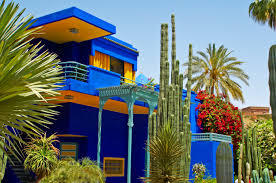
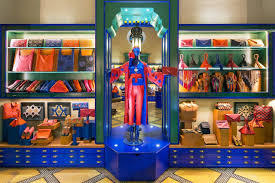
By the time I left, it was 5:30pm, and I was feeling hungry. I went to Le Douar which is a restaurant located 10 minutes away from the garden. I chose to get the Tangia Marrakchia which Is a famous Moroccan dish that is a lamb stew with garlic and lemons. Lamb is one of the main meat sources of Morocco just because it can be easily found in the country. My meal was 220 MAD (21.91 USD) and I tipped 22 MAD since 10% is the tipping custom.
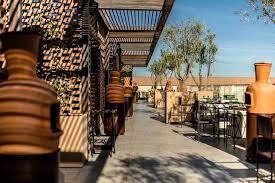
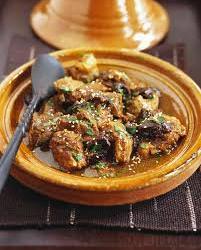
After my meal, I decided to head back to my room, and on the way there I decided to pick up a translation book because the most spoken language is Arabic. Once I got back, I went to sleep.
DAY TWO
I woke up today and decided to visit a famous religious building in Marrakesh. The Kasbah Mosque, located just a 15-minute walk away from my hotel, is a mosque built in 1185-1190. The building was commissioned by the caliph Yaqub al-Mansur for the new Marrakesh. 99% of the population in Morocco is Muslim and mostly all of them are Sunni. Sunni is the largest branch of Islam, and it differs from Shia because they believe that the Prophet did not explicitly declare a successor. The Kasbah Mosque is mainly for Sunni, but they still welcome Shia.

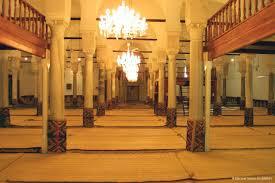
In the mosque, I stopped and look at the Saadian Tombs. The tombs were built in the 16th century by Sultan Ahmad al-Mansur who was the third ruler of the Saadian dynasty. The tombs have two main sections that have several chambers each. They also have very intricate carving on the walls, and color all over the tiles. The carvings depict scenes from Islamic history and mythology.

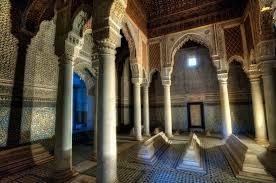
After visiting the mosque and learning more about the history of Islam in Morocco, I decided to finally get something to eat. I decided to stop at ViaVia Marrakech. ViaVia Marrakech was founded by a Belgian couple who loved travelling, and as they were travelling they found Morocco and decided to stay. I chose to get the Sweet Chicken Wings for an appetizer, the ViaVia Burger for my entrée, and Pastilla Au Lait for dessert. Pastilla Au Lait is a French dish that just translate to "dough with milk." My meal ended up being 300 MAD (29.88 USD) and I tipped 30 MAD due to the custom.
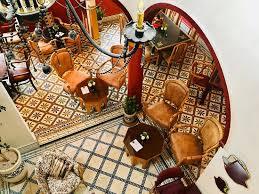

After eating lunch, I decided to visit Parc Lalla Hasna which is a famous tourist attraction in Marrakech. It is a huge park mainly used for bird watching. The top 5 birds you will most likely see while visiting are the Booted Eagle, Spotless Starling, Great Grey Shrike, Little Swift, and the Common Bulbul, but you can also see 42 different species. Parc Lalla Hasna is free and open to the public. Natives usually visit the park at night, and they just talk and stroll. The park is right next door, making its most notable feature the minaret, which is a tower attached to a mosque that Muslims use to pray.
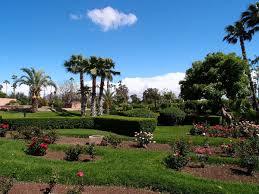

On my walk back to my hotel, I stopped by Cyber Park. Located directly in the heart of Marrakech, Cyber Park is 8 hectares and houses a museum and an institute of art. The park was built in the 18th century by the son of the Sultan, Moulay Abdelsalam. The main thing people do when visiting Cyber Park is see the telecommunication museum. They show off different pieces of furniture, photographs, and other pieces that show the advancements in society. You can also walk through the rose garden or use your computer due to the park's free internet access.
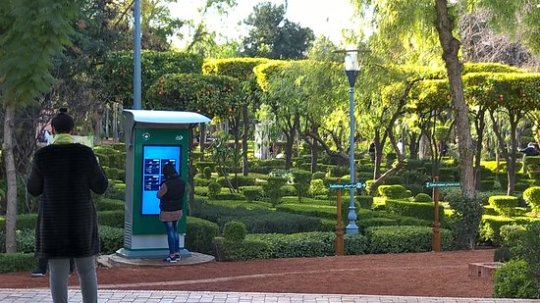

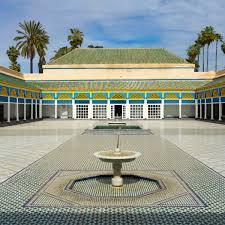
Once leaving the park, I continued on my walk back home and go to sleep after my long day of sightseeing.
DAY THREE
Today, I woke up and realized that I needed to hit the road immediately to make it to my next stay in Morocco. I was deciding to leave Marrakech and visit the countries capital, Rabat, located right on the shore and houses 1,959,000 people. I called a cab to get to my next Airbnb, located 3 hours and 41 minutes away. My cab fare ended up costing 2,303 MAD (229.39 USD). I got to my Airbnb named "Super Luigi" and I unpacked. My Airbnb was 1204 MAD (120 USD) a night.

Lucky for me, my Airbnb was located right next to a Syrian restaurant called Yamal Acham. I decided to get Mhamara which is a Middle Eastern dip made from walnuts and roasted red peppers. People usually eat this with a meze platter, but it still tastes good to eat by itself. The dip cost me 25 MAD (2.49 USD). For dessert, I got Salade de fruits, which is just a fruit salad. This also cost 25 MAD.


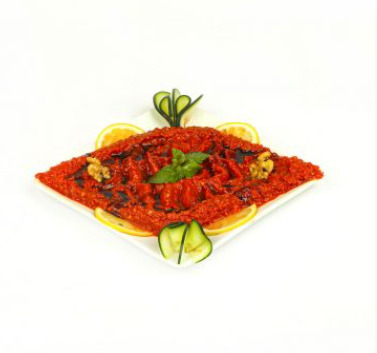
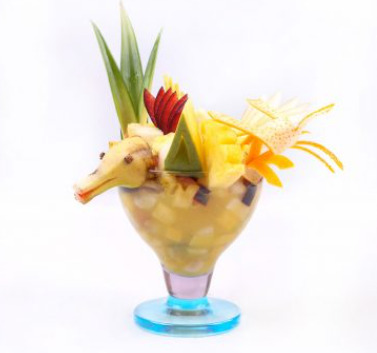
After lunch, I decided to travel to take the 6-minute cab ride to the Rabat Beach. Rabat Beach is a main tourist attraction in Morocco. The beach stretches 2.5km and that includes both private and public beaches. At Rabat Beach, you can participate in many different water activities such as, kayaking, windsurfing, jet-skiing, horseback riding, and sailing. I personally chose to go horseback riding because apparently Rabat is one of the best cities to go horseback riding in! I could not find a price for how much it costs, so I just assume it was free ¯\_(ツ)_/¯.
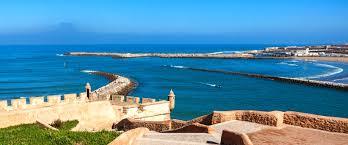
After my horseback ride on the beach, I decided to take a cab back to my Airbnb and spend the rest of the day inside.
DAY FOUR
I woke up and decided to go get something to eat. I chose to go to Hamza Food, located a 12-minute walk from my Airbnb. Hamza Food specializes in Kumpir which is a Turkey (country) dish that is a baked potato that is sliced open, and then you choose what toppings you want. I got Kumpir poulet which is just chicken added to the potato. My meal was extremely cheap, it was just 30 MAD (2.95 USD)!
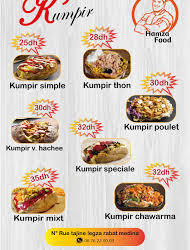

After my breakfast, I decided to head over to the Théâtre National Mohammed V. This theatre has many different showings. They offer music, operas, ballet, movies, private events, and children showings. They have different showings almost every single night. Today's showing at 11:30 was Cinderella in Rabat, which is a remake of the classic Cinderella story, but instead it takes place in Rabat. This was one of the children shows.

After the showing of Cinderella in Rabat, I decided to hop across the street to Nouzhat Hassan Garden. Just like any other park, Nouzhat Hassan Garden mainly consists of nature and an informational building. I thought this would be the perfect time to sit outside and learn about the country of Morocco. In 1912, Morocco was colonized by France, and gained independence in 1956, but French influences still remain in the country. There are many things that tourists need to know before travelling to Morocco. One of the biggest ones is to dress conservatively, even if the climate is Mediterranean and the average temperature year round is 86°F. Morocco is a Muslim country, and even if you don't practice Islam, it is still respectful to follow some of their customs that come with the religion. You are also expected to use your right hand for everything, as your left hand is used for chores and bathroom hygiene. Locals would find it extremely disrespectful if you used the left hand to open a door, touch a cup, or eat food. You are also not supposed to give praise. Giving compliments can weird out the locals as it is not how they were raised, so they can get uncomfortable if you were to do so.
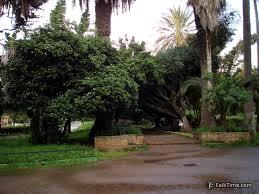

After my walk in the park and learning about Moroccan customs, I decided to get some dinner before heading to bed, as tomorrow I have my flight out of here and into Botswana. Close to Nouzhat Hassan Garden was a La Bamba Mexican restaurant. Here, I decided to get the Paella Bogavante which is a Paella with lobster. It cost 600 MAD (59.03 USD). After finishing my meal, I went back to my Airbnb and went to bed.
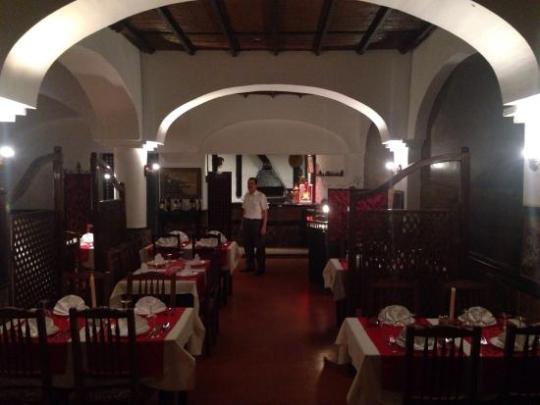
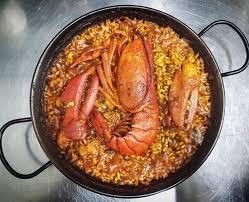
DAY FIVE
Today I left from Morocco to Botswana. While on the plane, I wanted to reflect on my time in Morocco. I really enjoyed being here. I liked seeing how much nature varies in Morocco compared to not only Minnesota, but Belize and Panama too. I like that I got a varied amount of food that wasn't all from one region of the world. I really appreciated trying Mhamara and embracing Moroccan culture. I am excited to head over to Botswana and see how Southern Africa lives.
0 notes
Text
Artistic Discoveries on a Budget: Marrakech Cultural Heritage Tours
Marrakech, a city steeped in history and artistic tradition, invites travelers to embark on a journey of cultural exploration without breaking the bank. With budget-friendly cultural heritage tours, visitors can delve into the rich tapestry of Marrakech’s artistic heritage, uncovering hidden gems and timeless treasures along the way. Here’s how these tours offer a gateway to artistic discoveries while staying within a reasonable budget:
Guided Museum Visits:
Marrakech boasts a diverse array of museums and cultural Morocco travel packages institutions, each offering a unique perspective on the city’s heritage. Budget-friendly cultural heritage tours often include guided visits to these museums, providing travelers with insights into Moroccan art, history, and culture. From the Museum of Marrakech, housed in a stunning 19th-century palace, to the Berber Museum, dedicated to showcasing Berber culture and traditions, these visits offer enriching experiences without breaking the bank.
Architectural Wonders:
The architecture of Marrakech is a testament to its rich cultural heritage, blending influences from Berber, Arab, and Andalusian traditions. Budget-friendly tours often include visits to iconic landmarks such as the Koutoubia Mosque, with its towering minaret, and the Saadian Tombs, adorned with intricate tilework and stucco decoration. Travelers can marvel at these architectural wonders and learn about their historical significance from knowledgeable guides, all while staying within their budget.
Artisan Workshops:
At the heart of Marrakech’s artistic heritage lies its skilled artisans, who continue to practice traditional crafts passed down through generations. Budget-friendly cultural heritage tours often take travelers behind the scenes to visit artisan workshops, where they can witness master craftsmen at work. From carpet weaving and pottery making to leather tanning and metalwork, these workshops offer a firsthand look at the meticulous craftsmanship that defines Marrakech’s cultural identity.
Cultural Performances:
No visit to Marrakech is complete without experiencing its vibrant cultural performances, from lively music to mesmerizing dance. Budget-friendly tours may include opportunities to attend traditional music and dance performances, providing travelers with a taste of Moroccan entertainment and hospitality. These cultural experiences offer a glimpse into the soul of Marrakech and its enduring artistic traditions.
Conclusion:
Marrakech cultural heritage tours offer budget-conscious travelers a wealth of opportunities to discover the city’s artistic treasures and historical wonders without overspending. Whether exploring museums, marveling at architectural landmarks, or witnessing traditional craftsmanship in action, these tours provide enriching experiences that celebrate Marrakech’s vibrant cultural heritage. With knowledgeable guides leading the way, travelers can embark on a journey of artistic discovery that is both affordable and unforgettable.
1 note
·
View note
Text
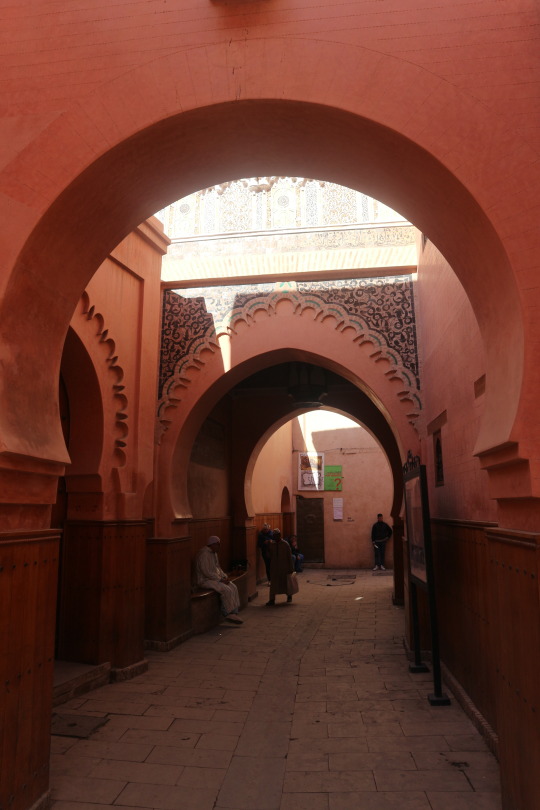


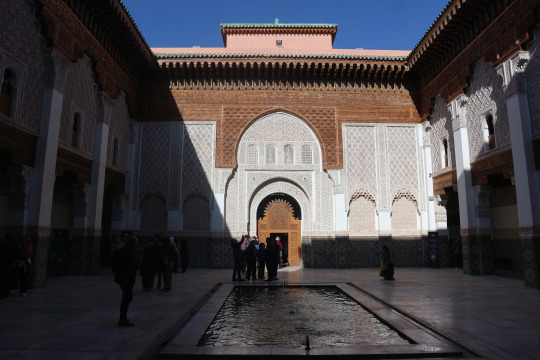


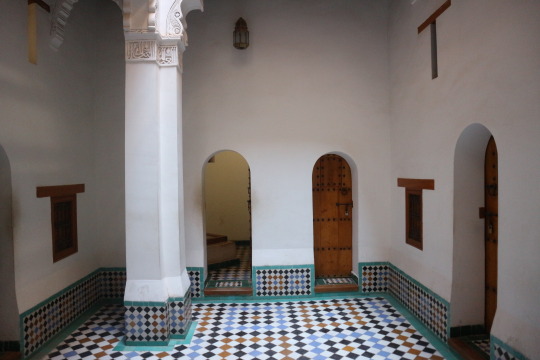
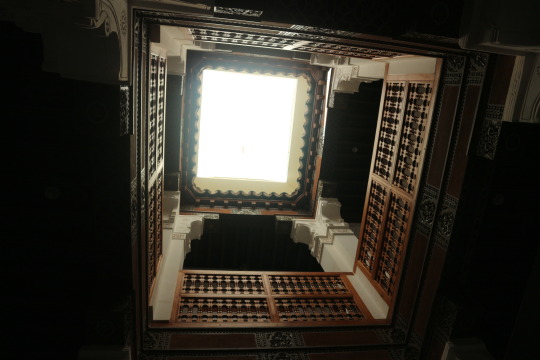
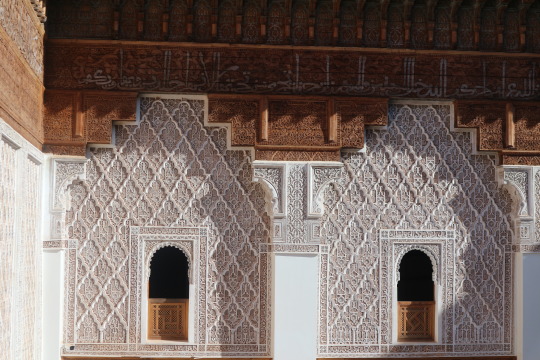

اللَّهُمَّ افْتَحْ لِي أَبْوَابَ رَحْمَتِكَ
The seventh and last part of my Morocco series (please see here, here, here, here, here and here for more).
Marrakech became the capital city of an empire spanning Africa and Europe when it was founded by the Almoravid dynasty in 1070 and Islam, which has been the foremost religion (alongside a large Jewish minority) since Morocco was conquered by the Arabs in 709 AD, has always set the tone of the city.
Ben Youssef Mosque was built here by Ali ibn Yusuf (1106-1142 AD), who was an Almoravid, and the site is now home to Ben Youssef Madrasa since 1565.
A madrasa, or theological school, has been here since Abu Al Hasan ibn Othman of the Marninid Dynasty (1244-1465) founded it between 1331 and 1348 and this building has stood since commissioned by Abdallah Al Ghalib of the Saadian dynasty (1549-1659), who also built palaces and tombs that you can read about in my other posts.
(This is mainly a post about the 16th and 17th centuries; please see here and here for earlier and later eras).
The Saadians were sharifs (descendants of Mohammed, the founder of Islam, or his family) and thus felt a duty that they took seriously, and carried out well, as you can see from what they left behind.
They were also mindful of the links to Europe which their country had had since European times, and which has left its mark in Morocco since the Koutoubia Mosque, built 1147 AD by the Almohad dynastY, who overthrew the Almoravids earlier that year. (The Koutoubia is twinned with a mosque in Cordoba, in what is now Spain, which sounds absolutely lush, though I’ve never been there).
As the Museum with No Frontiers points out, “if anything can be singled out as the leitmotif running through the area of the Mediterranean, it is diversity of expression combined with the harmony of sentiment, a sentiment more cultural than religious”. I’d love to test this out in Cordoba or Seville one day!
Indeed the Andalusi marble basin, built in 1002-1007 AD, went from Morocco to Cordoba and came back; it now lives here as a sign of those who came here after 1492, when the last Muslim power in what is now Spain was cast out.
At that time, all Muslims and Jews were expelled from the Spanish state, and many came here, as it was the nearest friendly country and many of their forefathers came from Morocco; they were just as much European as Islamic and African, and brought back a legacy that infuses all Saadian and later buildings.
Because the state religion was (and is) Islam, both theologians and lawyers were trained in a madrasa that taught 800 students and was thereby the largest in Morocco.
This school worked tirelessly until it was shut down in 1960; it then reopened as a museum in 1982 and was restored between 2018 and 2022 on the orders of King Mohammed VI, showing the links between religion of state that have always existed in Morocco, though without becoming an Iranian-style theocracy.
Since it was built just after a wave of migration from Europe to Morocco, and has strong European influences painted on to the Islamic bedrock (both Arabic and that of the Berber folk who have always lived here), this shows the sheer Moroccan-ness that makes Morocco distinctive.
فِى بُيُوتٍ أَذِنَ ٱللَّهُ أَن تُرْفَعَ وَيُذْكَرَ فِيهَا ٱسْمُهُۥ يُسَبِّحُ لَهُۥ فِيهَا بِٱلْغُدُوِّ وَٱلْـَٔاصَالِ
1 note
·
View note

